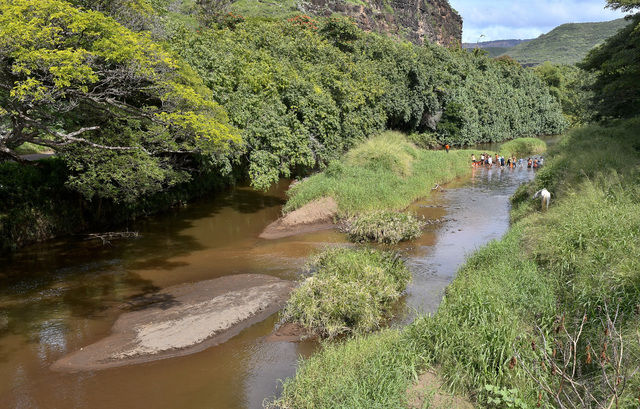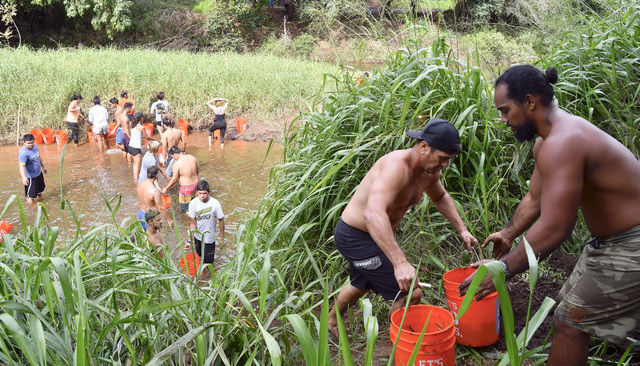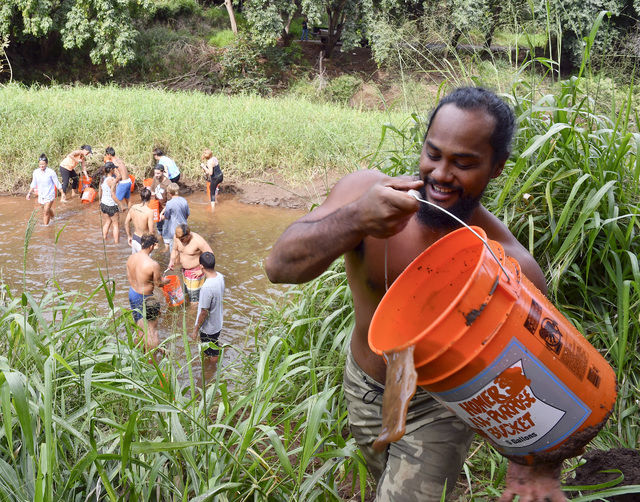WAIMEA — Jonathan Dulay frequented the Waimea River with his uncle when he was younger because his mother is especially fond of fish.
“She loves to eat all kinds of fish, so we would come down here, me and my uncle, and throw nets,” said Dulay, a senior at Waimea High School. “But it’s gotten drastically harder to catch fish.”
That’s because it’s become much more shallow since Dulay was a young kid.
“It’s used to be up to your waist when you crossed,” said Kinoa Rapozo, one of Dulay’s classmates. “Now, it’s nothing like it was.”
Several islands of silt have also built up in the middle of the river, creating one large island makai of the Waimea swinging bridge and a scattering of smaller islands mauka of the bridge.
On Friday, Dulay visited the area with about 15 of his classmates, on a mission to chip away at the group of silt islands, shoveling silt into five-gallon buckets and depositing the sediment onto the bank.
It’s a project the high school kids are working on with Kaina Makua, who farms in the area and daily sees the need to clear waterways in the Waimea Valley of sediment and invasive species.
“The rivers need to be healthy,” he said. “And these kids, they’re the ones doing it (clearing the river). What they’re doing here is important.”
On Friday, Makua was on the bank, receiving filled buckets being passed down a line of kids who spanned across the river.
He was passing the heavy buckets to Dan Ahuna, Office of Hawaiian Affairs Kauai and Niihau trustee, who attended the cleanup with Davis Price, also with OHA.
“At the high school, we spoke about how these islands happened and how it’s affecting the flow now,” Ahuna said. “And that’s why they’re here.”
The high school contacted Ahuna and Price to make sure their plan was pono before moving forward with the cleanup, and they touched base with the County of Kauai.
It was going to cost the county $500,000 to bring machinery in to clear the river, and there were several permits required for the action, according to Ahuna.
He said the kids decided to take things into their own hands to get the process started.
“The kids, they came up with the idea of coming out here and working on this,” Ahuna said. “It’s part of who they are.”
Makana Reilly, who is care taking Nomilu Fish Pond with her ohana, also visited the high school before the cleanup to share how the water flow in the river affects the fish ponds and the oceans.
“It’s all connected. What’s in the river comes down into the fish ponds and it goes out into the ocean,” she said. “And what these kids are doing here, they’re making a difference.”
Friday’s cleanup was the third targeting the sediment islands, Makua said.
“Last trip we had about seven people and we did 100 buckets in an hour and a half,” Dulay said. “This time we had 15 or 20 people and we did 100 buckets in half an hour.”
It’s the concept of laulima — many hands make light work — and instilling that concept in the kids is part of the project.
“If we have more numbers we can probably get this done in a short amount of time,” Dulay said.
On March 11 and 12, there’s a chance to do just that with two scheduled community work days dedicated to decimating the sediment islands that are constricting water flow in the river.
The workdays will run from 8 a.m. to 3 p.m., and everyone is invited to meet at the Waimea Swinging Bridge to help out.




